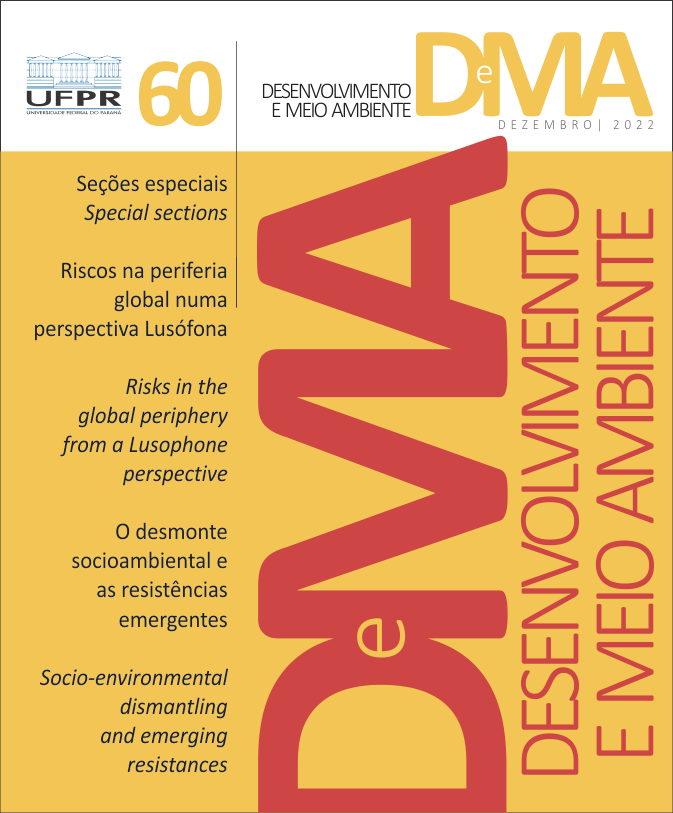A normalização da precariedade: uma etnografia do espaço da energia e da vida em risco em Vila Nova Esperança (São Paulo, Brasil)
DOI:
https://doi.org/10.5380/dma.v60i0.85630Palavras-chave:
risco, energia, desastres, periferia, São PauloResumo
O objetivo da pesquisa é investigar as interseções entre as configurações espaciais do risco de desastres e seus desdobramentos políticos, sociais e culturais. O artigo apresenta os resultados da primeira fase da pesquisa de campo, realizada entre setembro de 2021 e março de 2022 em Vila Nova Esperança, comunidade de baixa renda na periferia oeste de São Paulo. A pesquisa originou-se a partir da análise etnográfica do espaço, relativa ao acesso à infraestrutura e aos serviços energéticos, definidos como objeto de estudo através da noção de espaço da energia, trazida pela obra de Setha Low sobre etnografia do espaço e da cultura. A precariedade encontrada no espaço da energia amplia-se a outras dimensões do espaço habitado e suas relações sociais, abrangendo outras precariedades relacionadas ao risco de desastres e aos impactos das mudanças climáticas. O que emerge do levantamento das histórias das pessoas e do lugar é o caráter permanente e intertemporal da precariedade que, apesar das conquistas da comunidade, dos moradores e das moradoras, se apresenta como um fato político. Os resultados combinam a análise realizada com dados sobre a urbanização na periferia de São Paulo, no qual o trabalho etnográfico centrado no espaço e nas configurações espaciais do acesso à energia é integrado pelas narrativas dos e das integrantes da comunidade. Dessa triangulação emerge a combinação da construção social do risco biofísico e social como um elemento transversal que dá forma ao resultado principal do artigo: a multiplicação das formas e dinâmicas de produção social do risco como um processo que vai mais além do risco de desastres e dos impactos das mudanças climáticas. Nesse sentido o termo “normalização da precariedade” proposto no título é uma provocação, um convite à investigação sobre a permanência intertemporal da precariedade na periferia paulista.
Downloads
Publicado
Como Citar
Edição
Seção
Licença
Os Direitos Autorais sobre trabalhos publicados nesta revista são do autor, com direitos de primeira publicação para a revista. O conteúdo dos trabalhos publicados é de inteira responsabilidade dos autores. A DMA é um periódico de acesso aberto (open access), e adota a licença Creative Commons Atribuição 4.0 Não Adaptada (CC-BY), desde janeiro de 2023. Portanto, ao serem publicados por esta Revista, os artigos são de livre uso para compartilhar (copiar e redistribuir o material em qualquer suporte ou formato para qualquer fim, mesmo que comercial) e adaptar (remixar, transformar, e criar a partir do material para qualquer fim, mesmo que comercial). É preciso dar o crédito apropriado, prover um link para a licença e indicar se mudanças foram feitas.
Os conteúdos publicados pela DMA do v. 53 de 2020 ao v. 60 de 2022 são protegidos pela licença Creative Commons Atribuição – Não Comercial – Sem Derivações 4.0 Internacional.
A DMA é uma revista de acesso aberto desde a sua criação, entretanto, do v.1 de 2000 ao v. 52 de 2019, o periódico não adotava uma licença Creative Commons e, portanto, o tipo de licença não é indicado na página inicial dos artigos.




